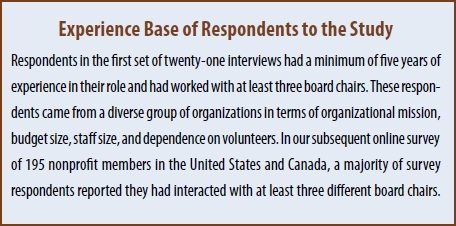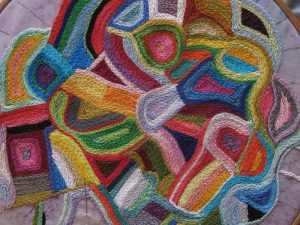
PHOTOGRAPH: “STANDING ROOM ONLY” BY SKIP HUNT
Editors’ note: This article was first published in summer 2007 and is featured in NPQ‘s special winter 2012 edition: “Emerging Forms of Nonprofit Governance.” A new conclusion brings the research up to date.
Most experienced observers of nonprofit governance agree that board chairs can have considerable influence on board operations. But not much research focuses on the critical position of board chairmanship and the factors that determine its potential for positive or negative impact.
To better understand how board chairs affect their organizations, we recently completed two phases of a research project (and have plans for a third). In 2006 we undertook the first phase of this pilot study, conducting in-depth interviews with twenty-one respondents in Seattle, Washington, and in Victoria, British Columbia. Respondents were split nearly evenly between experienced nonprofit board members and CEOs. In 2007 we launched the project’s second phase, which consisted of an online survey of 195 nonprofit leaders representing a variety of perspectives (including those of board chairs, board members, CEOs, staff service volunteers, and stakeholders) from across the United States and Canada to verify the results of the study.
Our research identifies three groups on which board chairs have influence: (1) other board members; (2) CEOs and management teams; and (3) external stakeholders, such as funders, regulators, and clients. Although our exploratory research doesn’t touch on this, we have developed a framework that outlines the factors that might shape the behavior of chairs, such as background (i.e., age, gender, education, and previous leadership experience); characteristics of other members in the relationship, such as the CEO; and characteristics of the organization (such as the age, mission, and culture). The organization’s larger environment—such as economic and political factors, the organization’s climate of competitiveness or cooperativeness, and so on—can also affect board chair behavior.
Phase-One Findings
Our preliminary research findings suggest that there is considerable commonality among those qualities respondents perceive as hallmarks of effective and ineffective chairs. Respondents perceive highly effective chairs as assets to their organization. Conversely, they view ineffective chairs as problematic for boards and the organization as a whole. The table on pages 88–89 features some of these common characteristics.
| The Highly Effective Chair* | The Highly Ineffective Chair* |
| The Chair’s Attitudes and Values (as perceived by board members and CEOs) | |
|
|
| The Chair’s Personality Traits (as perceived by board members and CEOs) | |
|
|
| The Chair’s Conduct (as perceived by board members and CEOs) | |
|
|
| The Chair’s Qualities (as perceived by CEOs) | |
|
|
| The Chair’s Relationships with Board Members (as perceived by board members) | |
|
|
| The Chair’s Relationships with Stakeholders (as perceived by all respondents) | |
|
|
| The Chair’s Impact on the CEO | |
|
|
| The Chair’s Impact on the Board | |
|
|
| The Chair’s Direct Impact on Stakeholders | |
|
|
| The Chair’s Indirect Impact on the Organization | |
|
|
*Responses indicated greater diversity when respondents were asked about their experience with ineffective chairs; responses for effective chairs were more uniform.

Findings from the Online Survey
In terms of the personal qualities of exceptional board chairs, the findings of the online survey mirror first-phase findings. Trustworthiness, intelligence, and good listening skills are the highest-rated qualities for board chairs; being dictatorial, critical, and motivated by self-interest are the lowest-rated qualities.
With the benefit of a larger database, we used factor analysis to identify which characteristics of effective and ineffective chairs hang together. Our analysis yielded five clusters of effective board chair leadership characteristics and one cluster of qualities common to ineffective chairs.
- Relationship competencies:
- Is flexible
- Is comfortable with people of all types
- Is nonjudgmental
- Has strong listening skills
- Has a calm demeanor
- Has a friendly persona
- Is humble
- Commitment and action competencies:
- Has a strong commitment to the organization
- Has a clear commitment to getting things done
- Uses a proactive approach
- Devotes time to the organization
- Analytic skill competencies:
- Can see the big picture
- Can clarify and resolve issues
- Can handle contentious issues
- “Willingness to create” competencies:
- Has high intelligence • Is an innovative thinker
- Has confidence
- Ability-to-influence competencies:
- Has connections and influence with key people
- Uses connections to advance the organization
The two lowest-rated characteristics of board chairs were combined to form one indicator of chair ineffectiveness, which we call “dominating behavior”:
- Is dictatorial and domineering
- Pursues a self-serving agenda rather than contributing to an organization’s well-being
Discussion
This article highlights the characteristics of highly effective and highly ineffective board chairs as perceived by those who work with them. The behavioral and personality characteristics of highly effective chairs are remarkably similar among the various groups of respondents to the online survey.
Sign up for our free newsletters
Subscribe to NPQ's newsletters to have our top stories delivered directly to your inbox.
By signing up, you agree to our privacy policy and terms of use, and to receive messages from NPQ and our partners.
Respondents highlight the same qualities and skills of effective chairs as those the literature cites as desirable characteristics of nonprofit leaders in general. Our findings are also consistent with several leadership theories. Ralph Stogdill, for example, suggests that effective leaders are charismatic, cooperative, and sociable and know how to influence others, while Shelley Kirkpatrick and Edwin Locke cite cognitive ability, motivation, and confidence as essential leadership qualities. The literature also cites the following characteristics of effective leaders, which parallel our findings:
- Being goal directed
- Having emotional maturity, self-awareness, and social awareness (also known as “emotional intelligence”)
- Being creative, flexible, and persistent
- Being committed and independent-minded and understanding the big picture; being compassionate and proactive (also known as “spiritual intelligence”)
Our findings are also consistent with the findings of Richard Leblanc and James Gillies, who conclude from a 2005 study of thirty-nine corporate boards and interviews with 194 board members that there are two types of board chairs. The first, which the authors refer to as “conductors,” are effective managers because they
[R]elate very well to management, have a keen interest in good governance and serve as the hub of all-important board activity. They understand group and individual dynamics and possess remarkable leadership skills, both inside and outside the boardroom. They relate exceptionally well to the CEO (if a nonexecutive chair), committee chairs and other directors. They lead the setting of the agenda, run meetings effectively, moderate discussion appropriately, manage dissent, work towards consensus and, most importantly, set the tone and culture for effective corporate governance.
The second type, known as “caretakers,” are ineffective because they either exert too much influence or not enough.
So What? The Practical Implications
The aim of our research was to learn more about the characteristics of outstanding board chair leadership. But we can also draw some conclusions about how a nonprofit organization can better select highly effective chairs.
The most important step is to develop a position description for the chair’s role. This should include specific responsibilities of the position vis-à-vis (a) the board, both as individuals and as a group during formal meetings; (b) the CEO and other members of the management team; and (c) external stakeholders. The results of our research can serve as a foundation for the elements these statements should contain.
A position description should also include the qualifications for the job, such as the required level of knowledge about the organization as well as the desired leadership characteristics and interpersonal skills. Again, the results of our research provide some guidelines on the kind of person one should look for.
One of the best ways to develop qualified board members for promotion to the chair position is by establishing a clear system of succession. Future chairs would be appointed to the position of chair elect or vice chair. The understanding would be that the person holding such a position would move into the chair position within a year or two. Those in such roles can then consciously understudy the chair role.
Finally, it is possible to improve the chances of selecting top-notch chairs if boards are willing to carry out formal evaluations of their own performance. In such a process, members can be asked, “Which board member do you think has the greatest potential as a future chairperson, and why?”
In short, the secret to consistently appointing highly effective board chairs lies in making the process more formal and thoughtful by identifying the kind of person you want and by making a conscious effort to find and develop that person for the role.
Five Years Later
While our research answered important questions about the leadership of chairpersons of nonprofit boards of directors, research since this time has explored which of the influences described in this article were the most important in explaining chair impact on nonprofit boards, CEOs, and organizations. The most powerful explanation of chair impact comes from the interactions between multiple influences, suggesting that chair leadership effectiveness is a multidimensional leadership construct. We have incorporated chair leadership into our board governance effectiveness research. The purpose of this research is to increase the capacity of boards to identify issues that challenge governance effectiveness, help boards process this information in order to make the best use of the results in board performance decision making, and determine the efficacy of the online performance assessment system in facilitating board and organizational change. To access this free service and University at Albany, SUNY–sponsored board research and development project, visit www.boardcheckup.com or contact Professors Harrison ([email protected]) and Murray ([email protected]) directly.
Yvonne D. Harrison is an assistant professor in the Department of Public Administration and Policy at the University of Albany, State University of New York, in Albany. Vic Murray is an adjunct professor in the School of Public Administration at the University of Victoria, British Columbia, Canada.













